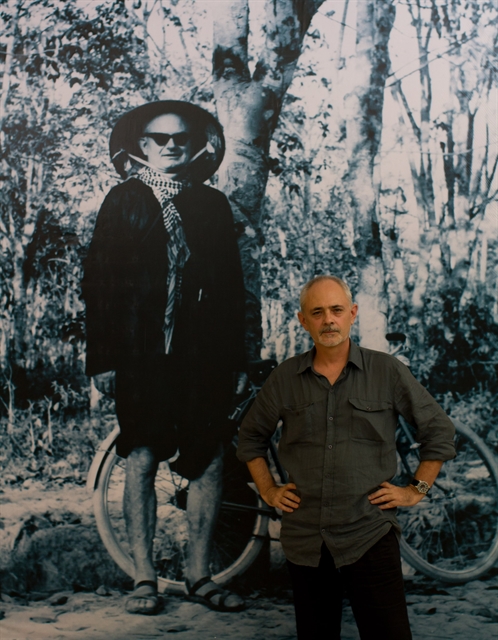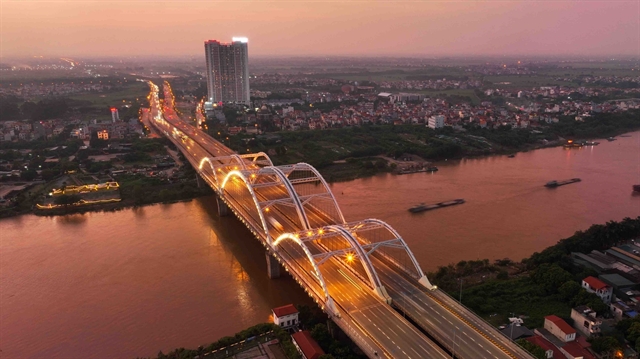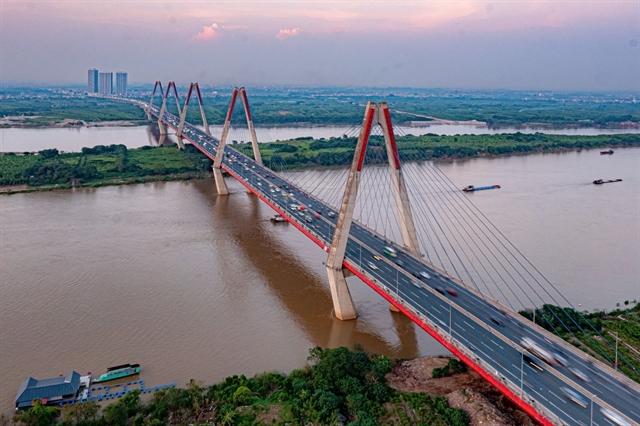 Life & Style
Life & Style

 |
| Golden autumn sun sets on Long Biên Bridge, a Hà Nội icon. VNA Photo: Phạm Tuấn Anh |
Long Biên Bridge, built over 120 years ago, was the first bridge, connecting the two banks of the Red River in Hà Nội, playing a significant role in the city’s history.
The iron bridge welcomed victorious Vietnamese troops returning from resistance bases to take over the capital city from the French occupation forces in the autumn of 1954.
Although it was badly damaged by air bombardments during the US war of destruction of North Việt Nam, the bridge remains a vital link for daily travel today. Additional bridges have been built over the years, transforming Hà Nội into a modern metropolis.
Long Biên Bridge: A Hà Nội icon
Constructed by the French from 1898 to 1902, Long Biên Bridge is not only a symbol of Hà Nội but also a lasting testament to Việt Nam’s resilience during years of wars of resistance.
Spanning 2,290m over the Red River, the bridge features 19 steel girders placed on 20 towering piers. The unique design included a single railway track in the centre, flanked by two lanes for vehicles and pedestrians.
Thăng Long Bridge: A symbol of Việt Nam-Soviet Union friendship
As Hà Nội grew and traffic demands increased, Thăng Long Bridge was constructed to alleviate pressure on Long Biên Bridge. Work began in 1974 with initial support from China but was halted and later completed with Soviet assistance in 1985. This steel truss bridge spans 3,250m, consisting of 25 spans in the main section and 46 approach spans. It has two levels: one for motor vehicles, and the other accommodating rail traffic. Thăng Long Bridge remains a symbol of the enduring friendship between Việt Nam and the Soviet Union.
Chương Dương Bridge: A witness to national renewal
Chương Dương Bridge, downstream from Long Biên, was constructed between 1983 and 1985 during a period of post-war reconstruction. At the time, Hà Nội’s need for improved connectivity between urban and suburban areas was growing. Long Biên Bridge was the only means of crossing the Red River, while Thăng Long Bridge was still under construction. The urgency to connect Hà Nội to its surrounding provinces led to the rapid completion of Chương Dương Bridge, entirely designed and built by the Vietnamese. Spanning 1,230m with 21 spans, the bridge was designed to handle 7,000 vehicles per day, but its capacity quickly increased to accommodate three to four times that number, cementing its role in the capital’s expanding transport network.
Thanh Trì Bridge: Việt Nam’s longest and widest pre-stressed concrete bridge
Thanh Trì Bridge stands as one of Việt Nam’s longest and widest pre-stressed concrete bridges, a key element of Hà Nội’s Ring Road 3. Construction began in 2002, and the bridge was completed in 2007 at a cost of US$410 million. Stretching 3,084m, with a width of 33m, the bridge features six traffic lanes, including four express lanes. It connects National Highway 1A with Hà Nội-Hải Phòng Expressway, making it a vital artery for the region’s traffic flow.
Đông Trù Bridge: A landmark of architectural innovation
 |
| LIGHTS ON: Đông Trù Bridge was built to commemorate the 60th anniversary of Hà Nội's Liberation Day. VNA/VNS Photo |
Completed in 2014, Đông Trù Bridge commemorates the 60th anniversary of Hà Nội’s Liberation Day. The bridge was built with advanced technological methods, including the use of concrete-filled steel tube arches with large spans, the first of its kind in Việt Nam. Spanning 1.1 km and connecting Long Biên and Đông Anh districts, Đông Trù Bridge is an integral part of Ring Road 2, improving access to the northern regions of the city and facilitating traffic to Nội Bài International Airport. The bridge’s innovative design and scale are a testament to Việt Nam’s growing expertise in construction.
Nhật Tân Bridge: A striking aesthetic landmark
 |
| CONNECTING: Nhật Tân Bridge is a symbol of the strong economic and diplomatic relationship between Việt Nam and Japan. VNA/VNS Photo |
Nhật Tân Bridge, opened in 2015, is the first cable-stayed bridge in Hà Nội and part of the city's Ring Road 2. Its total length of 8,900m includes a 1,500m central span supported by five diamond-shaped towers symbolising Hà Nội's five city entrances.
The bridge’s design, with its six cable-stayed spans, reflects both engineering prowess and aesthetic elegance. Inaugurated alongside the Nhật Tân-Nội Bài Expressway, the bridge has significantly reduced travel time between Nội Bài International Airport and the city centre.
The project, valued at VNĐ13.6 trillion (US$551 million), is a symbol of the strong diplomatic and economic partnership between Việt Nam and Japan.
Vĩnh Tuy Bridge: Expanding capacity to meet growing demand
Vĩnh Tuy Bridge, part of Ring Road 2, connects Hai Bà Trưng and Long Biên Districts. Initially completed in 2010, the bridge spans 5,800m, with 3,700m crossing the Red River.
In 2022, Vĩnh Tuy underwent a significant expansion, doubling its width from 19m to 38m, making it the widest bridge in Việt Nam. The expansion was part of a VNĐ2.5 trillion (US$110 million) project to enhance traffic flow and reduce congestion on Chương Dương and Long Biên bridges.
In addition to its practical role in reducing travel times, Vĩnh Tuy Bridge is noted for its impressive lighting and decoration system, creating a striking visual display at night.
A legacy of growth and modernisation
The bridges of Hà Nội are more than just structures that connect different parts of the city; they are historical witnesses to the capital’s transformation from a colonial city to a bustling modern metropolis.
Long Biên Bridge, with its century-long history, remains a symbol of resistance and resilience, while newer structures like Nhật Tân and Đông Trù bridges reflect Việt Nam’s growing technical capabilities and ambitions on the world stage.
Together, these bridges form a crucial part of Hà Nội’s transport infrastructure, facilitating the city’s economic growth and international connectivity.
As Hà Nội continues to expand, these bridges will remain vital links that bind the city’s past with its future. VNS